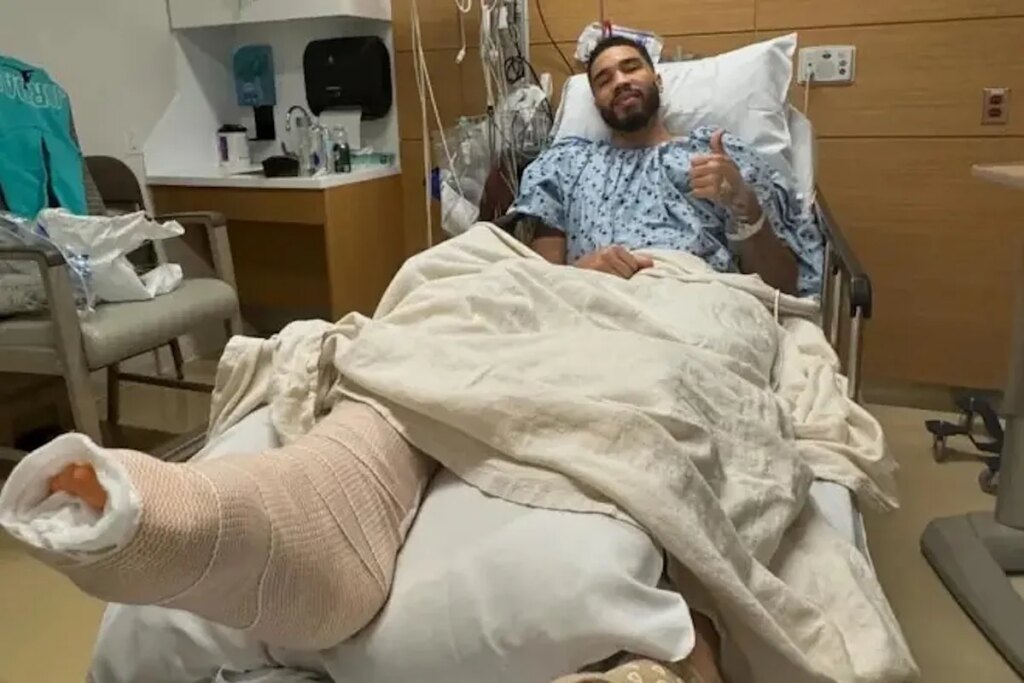The first thing to clarify is that the term quick, in an Achilles tendon injury refers to months. No one should think that Jayson Tatum will be ready for the start of next season. But in his case it is very significant the bite in the time that can give him to the recovery time.
The Celtics blog published an article in which they spoke with an expert on Achilles tendon injuries. And according to him, the player has some advantage in recovery time compared to other players who suffered the same injury.
Unlike most players who suffered a torn Achilles tendon, Tatum underwent surgery at New York Hospital for Special Surgery just hours after his injury. The surgery was performed by world-renowned specialist Dr. Martin O’Malley.
According to the expert consulted by the Celtics blog, the rarity of this operation is having it done so early. “It’s really very atypical, even for a professional athlete or someone of a very high profile. It’s very atypical,” explained Dr. Lou Soslowsky, director and founder of Penn’s Achilles Tendinopathy Research Center. “But at the same time it’s something very, very good.“
The speed of the intervention plays in Tatum’s favor, considering that only a few hours passed between the injury and the operation. Most cases in NBA players speak of days between one thing and the other. And that time can be crucial in recovery and even in its quality.
To give a few examples, Damian Lillard had to wait five days, DeMarcus Cousins took four days to undergo surgery, Wesley Mathews and Rudy Gay had to wait three days and even Kevin Durant saw how two days passed before entering the operating room.
Soslowsky explains the reasons for the delay, all of which are logical: “Fifty percent of those affected are not in their city of residence and the choice of the professional who will perform the surgery is often the subject of conversations between the injured person and his agent, his family, the management or friends. That delays everything. Those conversations already take one or two days. And once the surgeon is chosen, he may not be in town and has to travel, or he may not be available to operate that same day. More waiting time.”
What the expert was saying was that Tatum was in the right place at the right time. New York and the availability of Dr. O’Malley, a resident of the Big Apple. Those circumstances can make all the difference in his recovery.
“We don’t have a lot of data on recovery from a torn and repaired Achilles tendon just 12 hours after injury. It’s something that’s not very common,” Soslowsky told the Celtics blog.
In a tendon or ligament rupture, the faster the intervention, the better the prognosis. Waiting too long allows scar tissue to set in and inflammation to occur, which complicates healing.
“The longer you wait, the more options there are for biological agents and cells to infiltrate that will initiate scar formation,” Soslowsky explained. “Because this repair was done in less than a day, those processes had barely begun, and the broken ends were put back together before many of these adverse biological effects occurred. Therefore, the possibility of a faster recovery really exists.”
The logic, which the Celtics will likely adopt, is clearly not to force a quick reappearance, not to shorten deadlines. Soslowsky himself does not advise rushing: “At some point, in a few months, we’ll have a much clearer idea of whether he’s going to try to come back next season or not,” he said. “Being conservative, we would say that, well, it’s probably a 12-month rehab anyway.”
Perhaps the best news is not to return faster, but in better condition than expected after such a serious injury. But the player’s own environment is very optimistic. According to ESPN, Justin Tatum, Jayson Tatum’s father, was hopeful of seeing his son on the court in eight or nine months, meaning he could be playing again by February.
In this regard, Soslowsky pours cold water on the situation: “I think the probability of seeing him play next season is very low, honestly. But it might be better that way. We’ve seen that when people come back early, they do so with a high risk of recurrence. That would be devastating, something you don’t want to happen. Anyway, in a couple of months we’ll see how he’s progressing.”
In addition, Soslowsky remembers that it is not only about the repair of the tendon, but also about the physical condition of the player to return to high competition. “An Achilles tendon injury prevents you from doing any cardiovascular work for a long period of time. You can’t run, you can’t ride a bike, you can’t do aerobic work for months. And once the tendon is healed, the next thing is to regain the athlete’s aerobic work capacity, at least to get back to their level.”
Soslowsky concludes: “In Tatum’s case, the speed of the operation will give him two advantages, the possibility of returning earlier than other players who suffered the same injury, and the fact of returning in better condition because of the recovery.”
Read the full article here

